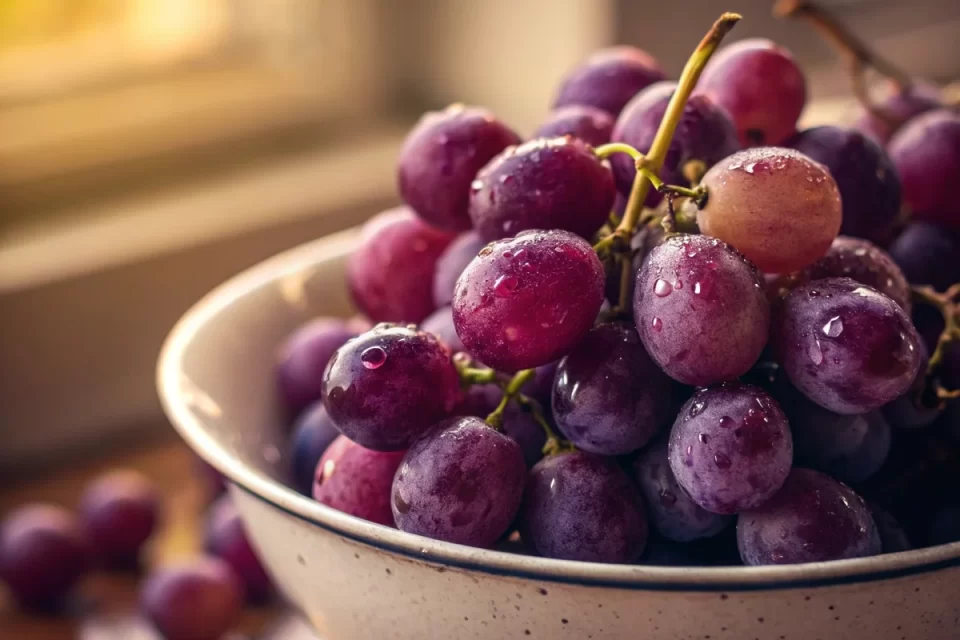Grapes (Vitis vinifera), small, juicy fruits grown in clusters, are celebrated for their sweet-tart flavor and nutritional benefits. A staple in diets worldwide, grapes are enjoyed fresh, dried as raisins, or transformed into wine and juice. This article explores grapes’ historical role in food, their nutritional profile, evidence-based health benefits, practical tips for use, and complementary food pairings, supported by scientific research.
History of Grapes in Culinary Traditions
Grapes have been cultivated for over 8,000 years, originating in the Near East, particularly modern-day Iran and Georgia. Archaeological evidence from 6000 BCE shows grapes were used for winemaking in the Caucasus. Ancient Egyptians incorporated grapes into diets and rituals, as depicted in tomb paintings from 3000 BCE. In Greece and Rome, grapes were central to cuisine and culture, eaten fresh, dried, or fermented into wine. By the Middle Ages, grapes and raisins were staples in European and Middle Eastern cuisines, featured in breads, stews, and desserts. In Asia, grapes appeared in Chinese and Indian dishes, often paired with spices. Today, grapes are a global ingredient, used in Mediterranean salads, American smoothies, and Middle Eastern pilafs, reflecting their versatility across sweet and savory applications.
Nutritional Profile
Grapes are low in calories and rich in antioxidants, vitamins, and fiber. Per 100 grams (approximately 2/3 cup of seedless grapes):
- Calories: 69 kcal
- Protein: 0.7g
- Fat: 0.2g (0g saturated)
- Carbohydrates: 18g (0.9g fiber, 15g sugars)
- Vitamins and Minerals:
- Vitamin C: 3.2mg (4% Daily Value)
- Vitamin K: 14.6µg (12% DV)
- Potassium: 191mg (4% DV)
- Copper: 0.1mg (11% DV)
- Manganese: 0.1mg (5% DV)
Grapes contain bioactive compounds like resveratrol, quercetin, and anthocyanins (especially in red/purple varieties), which contribute to their health benefits.
Note: Nutritional values are based on USDA data for raw, seedless grapes (red or green). Values may vary slightly depending on variety (e.g., Concord vs. Thompson) or preparation (e.g., fresh vs. dried).
Health Benefits
Grapes’ health benefits are driven by their antioxidants, fiber, and low glycemic index, supported by scientific research. Below are key benefits:
- Heart Health: Resveratrol and polyphenols in grapes may reduce cardiovascular risk. A meta-analysis in The American Journal of Clinical Nutrition (2015) found that grape polyphenol consumption improved blood pressure and reduced LDL cholesterol by 5–8 mg/dL.
- Antioxidant Support: Anthocyanins and quercetin combat oxidative stress. A study in Journal of Nutrition (2013) showed that grape antioxidants increased plasma antioxidant capacity, potentially lowering chronic disease risk.
- Brain Health: Resveratrol may protect cognitive function. Research in Frontiers in Aging Neuroscience (2014) indicated that grape-derived resveratrol improved memory and mood in older adults.
- Blood Sugar Regulation: Grapes’ fiber and low glycemic index help stabilize blood sugar. A study in Nutrients (2017) found that grape consumption improved insulin sensitivity in individuals with metabolic syndrome.
- Anti-Inflammatory Effects: Polyphenols in grapes reduce inflammation. A study in Molecular Nutrition & Food Research (2016) demonstrated that grape extracts decreased inflammatory markers like C-reactive protein.
Note: Benefits are most pronounced in red or purple grapes due to higher anthocyanin content. Moderate consumption (1–2 cups daily) is recommended to manage sugar intake. Those with diabetes should monitor portions due to natural sugars.
Tips for Using Grapes
- Selection: Choose plump, firm grapes with smooth skins, attached to green, flexible stems. Red/purple varieties offer more antioxidants.
- Storage: Refrigerate unwashed grapes in a perforated plastic bag for up to 1 month. Wash just before eating to prevent spoilage.
- Preparation: Rinse thoroughly under cold water. Freeze grapes for a refreshing snack or blend into smoothies without peeling.
- Cooking: Roast grapes at 400°F (200°C) for 15–20 minutes to intensify sweetness for desserts or savory dishes.
- Versatility: Use fresh grapes in salads, dried as raisins in baking, or juiced for beverages. Avoid overcooking to preserve nutrients.
- Allergy Awareness: Rare allergies to grapes exist, often linked to oral allergy syndrome. Test with small amounts if unsure.
Food Pairings for Grapes
Grapes’ sweet-tart flavor complements a variety of ingredients, enhancing both taste and nutrition. Below are five healthy combinations:
- Grapes + Spinach + Walnuts: Toss halved grapes with spinach and walnuts for a nutrient-dense salad rich in antioxidants, fiber, and omega-3s.
- Grapes + Greek Yogurt + Mint: Blend grapes with plain Greek yogurt and fresh mint for a creamy, protein-packed smoothie high in vitamin C.
- Grapes + Quinoa + Arugula: Combine roasted grapes with quinoa and arugula for a fiber-rich grain bowl with a peppery kick.
- Grapes + Chicken + Rosemary: Pair roasted grapes with grilled chicken and rosemary for a savory, protein-rich dish high in potassium.
- Grapes + Goat Cheese + Thyme: Serve halved grapes with a small amount of goat cheese and thyme on whole-grain crackers for a balanced appetizer rich in calcium.
Scientific and Academic Support
Grapes’ benefits are backed by peer-reviewed research:
- Zunino, S. J., et al. (2015). The American Journal of Clinical Nutrition: Grape polyphenols’ effects on cardiovascular health.
- Evans, M., et al. (2013). Journal of Nutrition: Grape antioxidants’ impact on plasma antioxidant capacity.
- Turner, R. S., et al. (2014). Frontiers in Aging Neuroscience: Resveratrol’s role in cognitive health.
- Banini, A. E., et al. (2017). Nutrients: Grapes’ effects on insulin sensitivity in metabolic syndrome.
- Georgiev, V., et al. (2016). Molecular Nutrition & Food Research: Grape extracts’ anti-inflammatory properties.
These studies confirm grapes’ potential to support heart health, brain function, and inflammation reduction, though long-term effects require further research.

